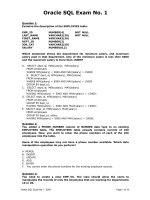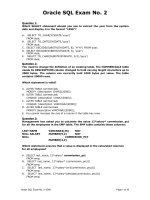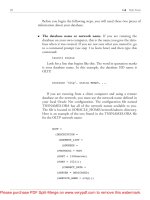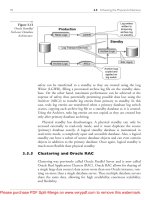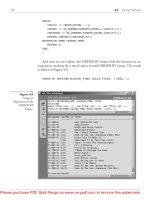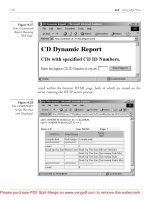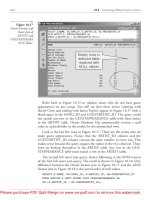Oracle SQL Exam No. 1
Bạn đang xem bản rút gọn của tài liệu. Xem và tải ngay bản đầy đủ của tài liệu tại đây (94.88 KB, 14 trang )
Oracle SQL Exam No. 1
Question 1:
Examine the description of the EMPLOYEES table:
EMP_ID NUMBER(4) NOT NULL
LAST_NAME VARCHAR2(30) NOT NULL
FIRST_NAME VARCHAR2(30)
DEPT_ID NUMBER(2)
JOB_CAT VARCHAR2(30)
SALARY NUMBER(8,2)
Which statement shows the department ID, minimum salary, and maximum
salary paid in that department, only of the minimum salary is less then 5000 and
the maximum salary is more than 15000?
A.
SELECT dept_id, MIN(salary(, MAX(salary)
FROM employees
WHERE MIN(salary) < 5000 AND MAX(salary) > 15000;
B.
SELECT dept_id, MIN(salary), MAX(salary)
FROM employees
WHERE MIN(salary) < 5000 AND MAX(salary) > 15000
GROUP BY dept_id;
C.
SELECT dept_id, MIN(salary), MAX(salary)
FROM employees
HAVING MIN(salary) < 5000 AND MAX(salary) > 15000; D.
SELECT dept_id, MIN(salary), MAX(salary)
FROM employees
GROUP BY dept_id
HAVING MIN(salary) < 5000 AND MAX(salary) < 15000; E.
SELECT dept_id, MIN(salary), MAX(salary)
FROM employees
GROUP BY dept_id, salary
HAVING MIN(salary) < 5000 AND MAX(salary) > 15000;
Question 2:
You added a PHONE_NUMBER column of NUMBER data type to an existing
EMPLOYEES table. The EMPLOYEES table already contains records of 100
employees. Now, you want to enter the phone numbers of each of the 100
employees into the table.
Some of the employees may not have a phone number available. Which data
manipulation operation do you perform?
A.
MERGE
B.
INSERT
C.
UPDATE
D.
ADD
E.
ENTER
F.
You cannot enter the phone numbers for the existing employee records.
Question 3:
You need to create a view EMP_VU. The view should allow the
users to
manipulate the records of only the employees that are working for departments
10 or 20.
Oracle SQL Exam No.1 - 2005
Page 1 of 14
Which SQL statement would you use to create the view EMP_VU?
A.
CREATE VIEW emp_vu AS
SELECT *
FROM employees
WHERE department_id IN (10,20);
B.
CREATE VIEW emp_vu AS
SELECT *
FROM employees
WHERE department_id IN (10,20)
WITH READ ONLY;
C.
CREATE VIEW emp_vu AS
SELECT *
FROM employees
WHERE department_id IN (10,20)
WITH CHECK OPTION;
D. CREATE FORCE VIEW emp_vu AS
SELECT *
FROM employees
WHERE department_id IN (10,20);
E.
CREATE FORCE VIEW emp_vu AS
SELECT *
FROM employees
WHERE department_id IN (10,20)
NO UPDATE;
Question 4:
Examine the data from the ORDERS and CUSTOMERS tables.
ORDERS
ORD_ID ORD_DATE CUST_ID ORD_TOTAÖ
100 12-JAN-2000 15 10000
101 09-MAR-2000 40 8000
102 09-MAR-2000 35 12500
103 15-MAR-2000 15 12000
104 25-JUN-2000 15 6000
105 18-JUL-2000 20 5000
106 18-JUL-2000 35 7000
107 21-JUL-2000 20 6500
109 04-AUG-2000 10 8000
CUSTOMERS
CUST_ID CUST_NAME CITY
10 Smith Los Angeles
15 Bob San Francisco
20 Martin Chicago
25 Mary New York
30 Rina Chicago
35 Smith New York
40 Lind New York
Oracle SQL Exam No.1 - 2005
Page 2 of 14
Evaluate the SQL statement:
SELECT *
FROM orders
WHERE cust_id = (SELECT cust_id
FROM customers
WHERE cust_name = 'Smith');
What is the result when the query is executed?
A.
ORD_ID ORD_DATE CUST_ID ORD_TOTAL
102 09-MAR-2000 35 12500
106 18-JUL-2000 35 7000
108 04-AUG-2000 10 8000
B.
ORD_ID ORD_DATE CUST_ID ORD_TOTAL
102 09-MAR-2000 35 12500
106 18-JUL-2000 35 7000
C.
ORD_ID ORD_DATE CUST_ID ORD_TOTAL
108 04-AUG-2000 10 8000
D.
The query fails because the subquery returns more than one row.
E.
The query fails because the outer query and the inner query are using
different
tables.
Question 5:
Which is an SQL*Plus command?
A.
INSERT
B.
UPDATE
C.
SELECT
D.
DESCRIBE
E.
DELETE
F.
RENAME
Question 6:
You need to produce a report for mailing labels for all customers. The
mailing label must have only the customer name and address. The
CUSTOMERS table has these columns:
CUST_ID NUMBER(4) NOT NULL
CUST_NAME VARCHAR2(100)
CUST_ADDRESS VARCHAR2(150)
CUST_PHONE VARCHAR2(20)
Which SELECT statement accomplishes this task?
A.
SELECT*
FROM customers;
B.
SELECT name, address
FROM customers;
Oracle SQL Exam No.1 - 2005
Page 3 of 14
C.
SELECT id, name, address, phone
FROM customers;
D.
SELECT cust_name, cust_address
FROM customers;
E.
SELECT cust_id, cust_name, cust_address, cust_phone
FROM customers;
Question 7:
Examine the structure of the EMPLOYEES table:
EMPLOYEE_ID NUMBER Primary Key
FIRST_NAME VARCHAR2(25)
LAST_NAME VARCHAR2(25)
Which three statements inserts a row into the table? (Choose three.)
A.
INSERT INTO employees
VALUES ( NULL, ‘John’,‘Smith’);
B.
INSERT INTO employees( first_name, last_name)
VALUES(‘John’,‘Smith’);
C.
INSERT INTO employees
VALUES (‘1000’,‘John’,NULL);
D.
INSERT INTO employees(first_name,last_name, employee_id)
VALUES ( 1000, ‘John’,‘Smith’);
E.
INSERT INTO employees (employee_id)
VALUES (1000);
F.
INSERT INTO employees (employee_id, first_name, last_name)
VALUES ( 1000, ‘John’,‘’);
Question 8:
You need to modify the STUDENTS table to add a primary key on the
STUDENT_ID column. The table is currently empty.
Which statement accomplishes this task?
A.
ALTER TABLE students
ADD PRIMARY KEY student_id;
B.
ALTER TABLE students
ADD CONSTRAINT PRIMARY KEY (student_id); C.
ALTER TABLE students
ADD CONSTRAINT stud_id_pk PRIMARY KEY student_id; D.
ALTER TABLE students
ADD CONSTRAINT stud_id_pk PRIMARY KEY (student_id); E.
ALTER TABLE students
MODIFY CONSTRAINT stud_id_pk PRIMARY KEY (student_id);
Question 9:
For which two constraints does the Oracle Server implicitly create a unique
index? (Choose two.)
A.
NOT NULL
B.
PRIMARY KEY
C.
FOREIGN KEY
D.
CHECK
E.
UNIQUE
Question 10:
In a SELECT statement that includes a WHERE clause, where is the GROUP BY
Oracle SQL Exam No.1 - 2005
Page 4 of 14
clause placed in the SELECT statement?
A.
Immediately after the SELECT clause B.
Before the WHERE clause
C.
Before the FROM clause
D.
After the ORDER BY clause
E.
After the WHERE clause
Question 11:
The CUSTOMERS table has these columns:
CUSTOMER_ID NUMBER(4) NOT NULL
CUSTOMER_NAME VARCHAR2(100) NOT NULL
STREET_ADDRESS VARCHAR2(150)
CITY_ADDRESS VARCHAR2(50)
STATE_ADDRESS VARCHAR2(50)
PROVINCE_ADDRESS VARCHAR2(50)
COUNTRY_ADDRESS VARCHAR2(50)
POSTAL_CODE VARCHAR2(12)
CUSTOMER_PHONE VARCHAR2(20)
Which statement finds the rows in the CUSTOMERS table that do not have a
postal code?
A.
SELECT customer_id, customer_name
FROM customers
WHERE postal_code CONTAINS NULL;
B.
SELECT customer_id, customer_name
FROM customers
WHERE postal_code = '________';
C.
SELECT customer_id, customer_name
FROM customers
WHERE postal_code IS NULL;
D.
SELECT customer_id, customer_name
FROM customers
WHERE postal code IS NVL;
E.
SELECT customer_id, customer_name
FROM customers
WHERE postal_code = NULL;
Question 12:
Examine the structure of the EMPLOYEES table:
EMPLOYEE_ID NUMBER Primary Key
FIRST_NAME VARCHAR2(25)
LAST_NAME VARCHAR2(25)
DEPARTMENT_ID NUMBER
SALARY NUMBER
What is the correct syntax for an inline view?
A.
SELECT a.last_name, a.salary, a.department_id, b.maxsal
FROM employees a,
(SELECT department_id, max(salary)maxsal
FROM employees
GROUP BY department_id) b
WHERE a.department_id = b.department_id
Oracle SQL Exam No.1 - 2005
Page 5 of 14
